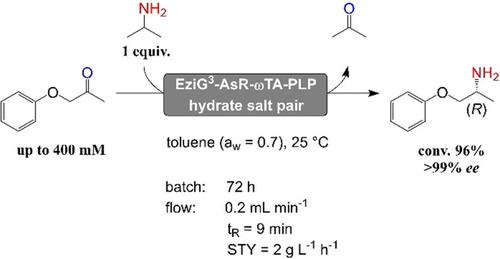当前位置:
X-MOL 学术
›
Adv. Synth. Catal.
›
论文详情
Our official English website, www.x-mol.net, welcomes your
feedback! (Note: you will need to create a separate account there.)
Continuous Flow Bioamination of Ketones in Organic Solvents at Controlled Water Activity using Immobilized ω-Transaminases.
Advanced Synthesis & Catalysis ( IF 4.4 ) Pub Date : 2020-02-17 , DOI: 10.1002/adsc.201901274 Wesley Böhmer 1 , Alexey Volkov 2 , Karim Engelmark Cassimjee 2 , Francesco G Mutti 1
Advanced Synthesis & Catalysis ( IF 4.4 ) Pub Date : 2020-02-17 , DOI: 10.1002/adsc.201901274 Wesley Böhmer 1 , Alexey Volkov 2 , Karim Engelmark Cassimjee 2 , Francesco G Mutti 1
Affiliation

|
Compared with biocatalysis in aqueous media, the use of enzymes in neat organic solvents enables increased solubility of hydrophobic substrates and can lead to more favorable thermodynamic equilibria, avoidance of possible hydrolytic side reactions and easier product recovery. ω-Transaminases from Arthrobacter sp. (AsR-ωTA) and Chromobacterium violaceum (Cv-ωTA) were immobilized on controlled porosity glass metal-ion affinity beads (EziG) and applied in neat organic solvents for the amination of 1-phenoxypropan-2-one with 2-propylamine. The reaction system was investigated in terms of type of carrier material, organic solvents and reaction temperature. Optimal conditions were found with more hydrophobic carrier materials and toluene as reaction solvent. The system's water activity (aw) was controlled via salt hydrate pairs during both the biocatalyst immobilization step and the progress of the reaction in different non-polar solvents. Notably, the two immobilized ωTAs displayed different optimal values of aw, namely 0.7 for EziG3-AsR-ωTA and 0.2 for EziG3-Cv-ωTA. In general, high catalytic activity was observed in various organic solvents even when a high substrate concentration (450-550 mM) and only one equivalent of 2-propylamine were applied. Under batch conditions, a chemical turnover (TTN) above 13000 was obtained over four subsequent reaction cycles with the same batch of EziG-immobilized ωTA. Finally, the applicability of the immobilized biocatalyst in neat organic solvents was further demonstrated in a continuous flow packed-bed reactor. The flow reactor showed excellent performance without observable loss of enzymatic catalytic activity over several days of operation. In general, ca. 70% conversion was obtained in 72 hours using a 1.82 mL flow reactor and toluene as flow solvent, thus affording a space-time yield of 1.99 g L-1 h-1. Conversion reached above 90% when the reaction was run up to 120 hours.
中文翻译:

使用固定化 ω-转氨酶在受控水活度下对有机溶剂中的酮进行连续流动生物氨化。
与水介质中的生物催化相比,在纯有机溶剂中使用酶可以增加疏水性底物的溶解度,并可以导致更有利的热力学平衡,避免可能的水解副反应并更容易回收产物。来自节杆菌属的 ω-转氨酶。 (AsR-ωTA) 和紫色色杆菌 (Cv-ωTA) 固定在受控孔隙率玻璃金属离子亲和珠 (EziG) 上,并应用于纯有机溶剂中,用 2-丙胺胺化 1-苯氧基丙烷-2-酮。从载体材料类型、有机溶剂和反应温度等方面对反应体系进行了研究。找到了使用更疏水的载体材料和甲苯作为反应溶剂的最佳条件。在生物催化剂固定步骤和不同非极性溶剂中的反应过程中,系统的水活度(aw)通过盐水合物对进行控制。值得注意的是,两种固定化的 ωTA 显示出不同的 aw 最佳值,即 EziG3-AsR-ωTA 为 0.7,EziG3-Cv-ωTA 为 0.2。一般来说,即使使用高底物浓度(450-550 mM)和仅使用一当量的 2-丙胺,在各种有机溶剂中也观察到高催化活性。在批量条件下,使用同一批 EziG 固定的 ωTA,在四个后续反应循环中获得了高于 13000 的化学周转率 (TTN)。最后,在连续流动填充床反应器中进一步证明了固定化生物催化剂在纯有机溶剂中的适用性。流动反应器表现出优异的性能,在几天的运行中没有观察到酶催化活性的损失。一般来说,大约。使用 1.72 小时内获得了 70% 的转化率。82 mL 流动反应器和甲苯作为流动溶剂,从而提供 1.99 g L-1 h-1 的时空产率。当反应进行120小时时,转化率达到90%以上。
更新日期:2020-02-17
中文翻译:

使用固定化 ω-转氨酶在受控水活度下对有机溶剂中的酮进行连续流动生物氨化。
与水介质中的生物催化相比,在纯有机溶剂中使用酶可以增加疏水性底物的溶解度,并可以导致更有利的热力学平衡,避免可能的水解副反应并更容易回收产物。来自节杆菌属的 ω-转氨酶。 (AsR-ωTA) 和紫色色杆菌 (Cv-ωTA) 固定在受控孔隙率玻璃金属离子亲和珠 (EziG) 上,并应用于纯有机溶剂中,用 2-丙胺胺化 1-苯氧基丙烷-2-酮。从载体材料类型、有机溶剂和反应温度等方面对反应体系进行了研究。找到了使用更疏水的载体材料和甲苯作为反应溶剂的最佳条件。在生物催化剂固定步骤和不同非极性溶剂中的反应过程中,系统的水活度(aw)通过盐水合物对进行控制。值得注意的是,两种固定化的 ωTA 显示出不同的 aw 最佳值,即 EziG3-AsR-ωTA 为 0.7,EziG3-Cv-ωTA 为 0.2。一般来说,即使使用高底物浓度(450-550 mM)和仅使用一当量的 2-丙胺,在各种有机溶剂中也观察到高催化活性。在批量条件下,使用同一批 EziG 固定的 ωTA,在四个后续反应循环中获得了高于 13000 的化学周转率 (TTN)。最后,在连续流动填充床反应器中进一步证明了固定化生物催化剂在纯有机溶剂中的适用性。流动反应器表现出优异的性能,在几天的运行中没有观察到酶催化活性的损失。一般来说,大约。使用 1.72 小时内获得了 70% 的转化率。82 mL 流动反应器和甲苯作为流动溶剂,从而提供 1.99 g L-1 h-1 的时空产率。当反应进行120小时时,转化率达到90%以上。











































 京公网安备 11010802027423号
京公网安备 11010802027423号